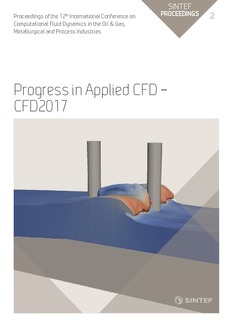| dc.contributor.author | Lu, Jiangtao | |
| dc.contributor.author | Peters, E.A.J.F. | |
| dc.contributor.author | Kuipers, J.A.M. | |
| dc.date.accessioned | 2018-01-28T13:16:26Z | |
| dc.date.available | 2018-01-28T13:16:26Z | |
| dc.date.issued | 2017 | |
| dc.identifier.isbn | 978-82-536-1544-8 | |
| dc.identifier.issn | 2387-4295 | |
| dc.identifier.uri | http://hdl.handle.net/11250/2480025 | |
| dc.description.abstract | In this paper, an efficient ghost-cell based immersed boundary method is introduced to perform direct numerical simulation (DNS) of particulate flows. The fluid-solid coupling is achieved by implicit incorporation of the boundary conditions into the discretized momentum, thermal and species conservation equations of the fluid phase. Taking the advantage of a second order quadratic interpolation scheme, different boundary conditions could be realized consistently in our ghost-cell based immersed boundary method. The heat and mass transport in a fluid-particle system is coupled through the solid temperature, which offers a dynamic boundary condition for the fluid thermal equation. The present simulations are performed for three different fluidsolid systems. The first one is the unsteady mass and heat diffusion in a large pool of quiescent fluid. The solution of the solid temperature development obtained from DNS is compared with the “exact” solution obtained from a standard second-order finite difference technique. Following that, we consider a stationary sphere under forced convection. The steady state temperature of the particle can be calculated from the fluidsolid mass and heat transfer rates, which are obtained from the well-known empirical Ranz-Marshall and Frössling correlations. The last simulation case is an in-line array of three spheres, the so-called three-bead reactor. The computed adiabatic temperature rise obtained from DNS shows good agreement with the value calculated from the overall species conversion ratio of the reactor. | nb_NO |
| dc.language.iso | eng | nb_NO |
| dc.publisher | SINTEF Academic Press | nb_NO |
| dc.relation.ispartof | Proceedings of the 12th International Conference on Computational Fluid Dynamics in the Oil & Gas, Metallurgical and Process Industries | |
| dc.relation.ispartofseries | SINTEF Proceedings;2 | |
| dc.subject | Direct Numerical Simulation; DNS | nb_NO |
| dc.subject | Ghost-cell based immersed boundary method | nb_NO |
| dc.subject | Particulate flows | nb_NO |
| dc.subject | Multiphase heat and mass transfer | nb_NO |
| dc.title | Direct numerical simulation of coupled heat and mass transfer in fluid‐solid systems | nb_NO |
| dc.type | Chapter | nb_NO |
| dc.type | Conference object | nb_NO |
| dc.type | Peer reviewed | nb_NO |
| dc.description.version | publishedVersion | nb_NO |
| dc.subject.nsi | VDP::Technology: 500 | nb_NO |
